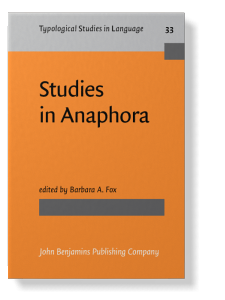Studies in Anaphora
Editor
The last 15 years has seen an explosion of research on the topic of anaphora. Studies of anaphora have been important to our understanding of cognitive processes, the relationships between social interaction and grammar, and of directionality in diachronic change. The contributions to this volume represent the “next generation” of studies in anaphora — defined broadly as those morpho-syntactic forms available to speakers for formulating reference — taking as their starting point the foundation of research done in the 1980s. These studies examine in detail, and with a richness of methods and theories, what patterns of anaphoric usage can reveal to us about cognition, social interaction, and language change.
[Typological Studies in Language, 33] 1996. xii, 518 pp.
Publishing status: Available
© John Benjamins Publishing Company
Table of Contents
-
Introduction | p. vii
-
The Discourse-referential and Typological Motivation of Pronominal Procliticization vs. EncliticizationWerner Abraham | p. 1
-
Referential Strategies and the Co-Construction of Argument Structure in Korean AcquisitionPatricia M. Clancy | p. 33
-
Ad Hoc Hierarchy: Lexical Structures for Reference in Consumer Reports ArticlesSusanna Cumming and Tsuyoshi Ono | p. 69
-
Proper Names as a Referential Option in English ConversationPamela A. Downing | p. 95
-
Interactional Motivations for Reference Formulation: He had. This guy had, a beautiful, thirty-two O:ldsCecilia E. Ford and Barbara A. Fox | p. 145
-
On Sources of Demonstratives and AnaphorsZygmunt Frajzyngier | p. 169
-
Demonstratives in Narrative Discourse: A Taxonomy of Universal UsesNikolaus P. Himmelmann | p. 205
-
Anaphora in Russian Narrative Prose: A Cognitive Calculative AccountAndrej A. Kibrik | p. 255
-
Anaphora, Deixis, and the Evolution of Latin IlleFlora Klein-Andreu | p. 305
-
Conceptual Grouping and Pronominal AnaphoraRonald W. Langacker | p. 333
-
Patterns of Anaphora in To’aba’ita Narrative DiscourseFrank Lichtenberk | p. 379
-
New Directions in ReferentialityMarianne Mithun | p. 413
-
Some Practices for Referring to Persons in Talk-in-Interaction: A Partial Sketch of a SystematicsEmanuel A. Schegloff | p. 437
-
Topic Discontinuity and Zero Anaphora in Chinese Discourse: Cognitive Strategies in Discourse ProcessingLiang Tao | p. 487
-
Index | p. 515
Cited by (18)
Cited by 18 other publications
Laury, Ritva, Michael C. Ewing & Sandra A. Thompson
2024. Chapter 1. Toward the interactional relevance of (non)referentiality. In (Non)referentiality in Conversation [Pragmatics & Beyond New Series, 344], ► pp. 1 ff. 
Camus, Laurent & Lorenza Mondada
Kuteva, Tania, Bernd Heine, Bo Hong, Haiping Long, Heiko Narrog & Seongha Rhee
Alvanoudi, Angeliki
Levinson, Stephen C.
2017. Living with Manny’s dangerous idea. In Enabling Human Conduct [Pragmatics & Beyond New Series, 273], ► pp. 327 ff. 
Jacquin, Jérôme & Marta Zampa
Simpson, Andrew, Zoe Wu & Yan Li
Fox, Barbara A. & Sandra A. Thompson
OBANA, YASUKO
Tsuyoshi Ono & Sandra A. Thompson
Ono, Tsuyoshi & Sandra A. Thompson
2024. Chapter 7. The indeterminacy and fluidity of reference in everyday conversation. In (Non)referentiality in Conversation [Pragmatics & Beyond New Series, 344], ► pp. 123 ff. 
Rosen, Nicole
Laury, Ritva
De Mulder, Walter
[no author supplied]
This list is based on CrossRef data as of 20 july 2024. Please note that it may not be complete. Sources presented here have been supplied by the respective publishers. Any errors therein should be reported to them.
Subjects
Main BIC Subject
CF: Linguistics
Main BISAC Subject
LAN009000: LANGUAGE ARTS & DISCIPLINES / Linguistics / General

